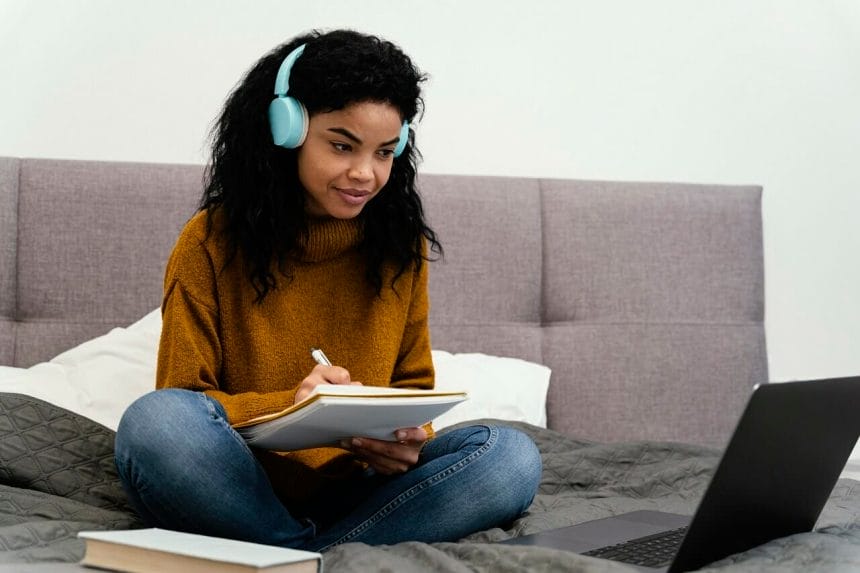In this article, we tackled the concept of learning styles and how discovering your learning style can make your grades do a complete 360 spin.
There’s a common saying that goes “different strokes, different folks” When you’re in school, you’ll come across all sorts of people from different walks of life, each person with a story entirely alien from the next. That’s the beauty of life.
During your time in school, you may have noticed that some people found it easier to study than others and got better grades even though it seemed like they weren’t doing anything different from the next person.
While it’s true that some people are naturally gifted in terms of academic performance, it takes more than fate to be a straight-A student.
Next, we’re going to:
- define learning styles
- explain their various types
- and emphasize the importance/ benefits of knowing what style suits you best
Simply put, a learning style is anything that facilitates learning. One person can have more than one style, but like traits, one will dominate others. A few things that could dominate our learning styles include culture, age, and our personal experiences.
Types of learning styles
In this section, we discussed the seven types of learning styles.
Visual (spatial) learning style
As the name suggests, visual learners are people who learn best by seeing. They do well with diagrams, images, graphs, and videos.
Signs that hint you could be a visual learner:
- Understanding a concept better after seeing a diagram
- Never forgetting a face
- Doodling during lectures to retain information
- Using graphs to understand figures better
For visual learners, study time is optimized when you use diagrams, images, and videos to explain wordy/written parts of your notes. We would also advise you to color-code your notes to make them visually appealing. You may also find flashcards helpful when studying.
Aural learning style
Aural learners learn best through listening. You may have noticed certain people in your class who made sure they paid extra attention to lectures when ongoing. They may not take any notes during the course, but after the class, they can regurgitate everything discussed. These types of people are called aural or auditory learners.
You may be an aural learner if you have the following characteristics:
- Retain information better when passed orally
- Enjoy lectures
- Cannot concentrate in a noisy environment
- Enjoy talking in general
Auditory learners can improve their studying experience by reading aloud, joining study groups, and listening to discussions, joining debates and Q&A sessions.
Verbal learning style
Verbal learners are often confused with aural learners, and while they share some similarities, the two are different. These learners are people who digest information best when presented in written or spoken form.
Here we listed a few characteristics of verbal learners:
- Possess a rich vocabulary
- Love word games such as scrabble
- Gifted at learning languages
- Excel at reading and writing activities
Verbal learners process information better when presented in spoken or written form. Avoid diagrams and charts because they may be tricky for you to grasp. Instead, use mnemonics and acronyms to boost your learning experience.
Physical (kinesthetic) learning style
If you are a physical learner, you learn best when interacting with the subject they are learning physically. They do this in the form of hand movements, writing, lab work, and demonstrations. Therefore, these types of learners will be more drawn to careers that involve many activities like surgery, dancing, sports, and carpentry.
- Common traits of physical learners are:
- They learn best through hands-on activity
- They lose interest quickly and have trouble sitting still
- They may struggle with subjects like spelling
- Excel at sports
For physical learners, the best way to optimize their studying is to make use of their tactile senses. So discover ways to get physical what you’re learning.
Logical learning style
Logical learners have a great sense of reasoning. They approach learning systematically and love deciphering patterns in concepts or following steps to reach the desired result. Thus, their strong points are areas of analysis, logic, and problem-solving.
Topics like mathematics, chemistry, computer sciences are of interest to logical learners. This is because they enjoy watching these abstract concepts become a reality through hands-on projects like building software.
You may be a logical thinker if you portray the following traits:
- Struggling with creativity
- Excelling at subjects with rules and procedures
- Highly organized and detail-oriented
Logical learners learn best with visual aids such as diagrams and graphs. This is because they are gifted at visualizing abstract concepts into actionable steps.
Social learning style
Social learning is best when with other people. If you’ve noticed that you learn faster and better by communicating with others, you might be a social learner. The communication could be verbal or non-verbal.
Some common characteristics of social learners are:
- They love to work in groups or teams
- They struggle working in isolation
- They make new friends naturally
- They are vocal and love to hear what others have to say
A study tip for social learners is to be part of a study group. This way, you have a group of people you can discuss your ideas with and learn from their ideas.
Solitary learning style
There’s always that one student who seems to be self-sufficient. Whenever they’re in class, it’s like they know as much as the teacher or more. When they miss a class, they still pick up ideas quickly. You hardly see them studying with anyone. They’re comfortable learning on their own.
People who become authors and researchers are often solitary learners. They learn better when alone and without distractions.
Characteristics most solitary learners have include:
- Keeping a journal or diary
- Struggling to work in groups
- Setting goals and making plans
- Enjoying alone time
- High self-esteem
- Independence
The best way to study as a solitary learner is to find a quiet place away from distractions, such as a library. Then, plan out a study timetable or checklist of topics you want to cover and stick to it.
Benefits of knowing your learning style
There are numerous benefits attached to knowing your learning style; we mentioned a few of them below:
Improved self-esteem
There’s no denying that our grades can affect the way we view ourselves. We often feel bad for getting low or failing grades, especially when we studied and expected better. However, when we understand our learning style, we learn better and thus get better grades.
This has a positive impact on how we view ourselves and raises our self-esteem. We don’t feel like we aren’t good enough for school or that everyone else is better than we are.
Easier success in school
Nobody likes to struggle for anything, and to work tirelessly in school only to be met with barely average grades can be very discouraging. It leaves us feeling we can never get to the peak of our academics.
If you understand the concept of learning styles and how they can impact your grades, this situation can be avoided. You would be learning in the best way possible and succeeding in school with ease.
Enables you enjoy the learning process
In life, we learn till we die; since it is something that is unavoidable, why not make the best of it? Many people would enjoy school and learn more if they approached it with their learning style.
Conclusion
Nobody was born for school, yes some are better at it than others, but the reason isn’t left to fate. With the right study strategy, you can become a star-student too. The first step is to understand your needs by identifying your preferred learning style.
Once you can do that, learning becomes easier, your self-image goes up, and you develop healthy feelings towards education. Not only will it help you in the classroom, it will also contribute to your success outside the four walls of school.



















